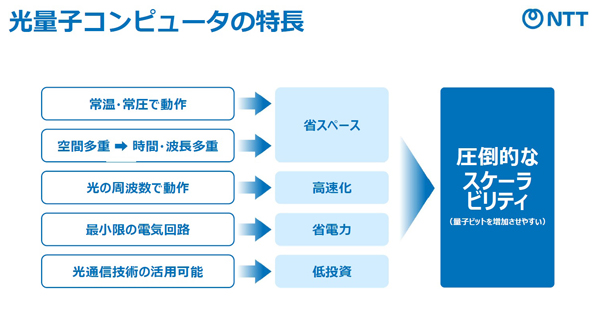NTT Suggests the Overwhelming Potential of Optical Quantum Computers, Applying Optical Communications Technology to Gain Superiority

At the NTT R&D Forum 2025, Shingo Kinoshita, Executive Officer and Head of Research and Development Planning at NTT, took the stage to explain the key points of optical quantum computers, the company’s next step in its IOWN initiative.

木下氏(Mr. Kinoshita)
The AI era will require enormous resources. Take power consumption, for example. It’s said that a single LLM training session requires 40,000 megawatts, equivalent to the power consumed by 40 nuclear power plants.
In light of this situation, NTT is pursuing an approach that streamlines and reduces the power consumption of the AI execution and learning environments themselves. NTT is also taking an approach that improves the efficiency of the AI itself with lightweight AI like tsuzumi.
Kinoshita stated, “These two are classical approaches to information processing, and we cannot solve these problems without considering information processing beyond our current state. At NTT, we are focusing on optical quantum computers from the perspective of fundamentally or dramatically improving computational performance.”
Optical quantum computers are an entirely new type of computer. They use light waves as quantum bits, and through superposition and interference, they achieve incredible computing power. While current AI requires enormous amounts of energy, quantum AI utilizes the superposition and interference of light to enable deeper learning while consuming less energy.
To briefly summarize the basic operation of an optical quantum computer, quantum light is first created, and “quantum entanglement” is generated using photons from the quantum light source. This quantum entanglement is woven together to form a single piece of fabric. The necessary programming for control is performed in the quantum entanglement part, and this information is read by a measuring device to enable actual processing.
Optical quantum computers have three technical key points. The first is the quantum light source. The higher the quality of the light source, the greater the amount of quantum light that can be generated. The more quantum light there is, the greater the computational performance. The second is increasing the number of entangled quanta. The third is the performance of the measuring device. The faster the measurement speed, the better the performance.
“NTT is currently focusing on the areas of quantum light sources and measurement. Optical quantum computers have a strong affinity with communications technology. Optical wavelength division multiplexing transmission technology, low-loss multicore fiber, and optical amplification technologies can be directly applied to optical quantum computers. In that sense, NTT has considerable potential, with good investment efficiency,” explains Kinoshita.
Optical quantum computers operate at room temperature and pressure. This is another major feature. Quantum computers using other methods, such as superconducting methods, require cooling equipment, which is considered difficult to miniaturize. In contrast, optical quantum computers only use light sources and mirrors, so they do not require cooling. This allows for greater device efficiency and chip integration, making them more compact.
What are the benefits of miniaturization? For example, optical quantum computers excel at time multiplexing, while other methods increase the number of quantum bits using spatial multiplexing. With spatial multiplexing, parallelization requires a rapid increase in the number of devices. With time-multiplexing optical quantum computers, increasing communication speeds increases multiplexing, improving performance without expanding the space, making them more investment-efficient.
※Translating Japanese articles into English with AI
